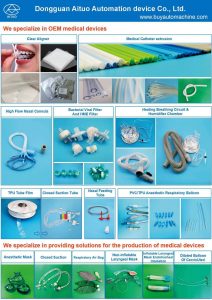Medical balloons have a wide range of applications in the field of medicine. They are typically made from materials like silicone or latex and can be inflated or deflated as needed for various medical procedures. Some common medical balloon applications include:
- Angioplasty: Medical balloons are used in angioplasty procedures to open narrowed or blocked blood vessels, such as coronary arteries. Inflating the balloon at the site of the blockage helps widen the vessel and improve blood flow.
- Stent Placement: Balloons are often used in conjunction with stents. After a balloon angioplasty, a stent (a mesh-like tube) is inserted at the same location to keep the vessel open. The balloon is inflated to expand the stent, which stays in place to maintain vessel patency.
- Gastrointestinal Procedures: In gastroenterology, balloons are used for various purposes, including dilation of esophageal strictures, treatment of achalasia (a disorder of the esophagus), and removal of gallstones from the bile ducts.
- Gynecology: Medical balloons are employed in procedures like uterine balloon therapy, where they are inserted into the uterus and filled with fluid to treat conditions like abnormal uterine bleeding or postpartum hemorrhage.
- Urology: In urology, balloons are used for procedures such as urinary catheter balloon inflation, dilation of urethral strictures, and placement of ureteral stents.
- Ophthalmology: In some eye surgeries, balloons are used to apply controlled pressure to specific areas of the eye to treat conditions like glaucoma or to aid in retinal reattachment surgery.
- Endoscopy: Balloons are used in endoscopic procedures to dilate strictures in the gastrointestinal tract, esophagus, or colon, making it easier for medical professionals to access and treat these areas.
- Eustachian Tube Dilation: Balloons can be used to dilate the Eustachian tube in the ear to treat conditions like chronic ear infections and Eustachian tube dysfunction.
- Dermal Applications: In dermatology, balloons are utilized for tissue expansion in reconstructive surgeries, such as breast reconstruction after mastectomy.
- Aortic Aneurysm Repair: Medical balloons can be used in endovascular procedures to place and secure aortic stent grafts within abdominal or thoracic aortic aneurysms.
- Gastrointestinal Obesity Treatments: Intragastric balloons can be inserted into the stomach and inflated to help with weight loss by creating a feeling of fullness.
- Bronchoscopy: Balloons are used in bronchoscopy procedures to dilate narrowed airways or to stop bleeding in the respiratory tract.

These are just a few examples of the many medical applications of balloons. Their versatility, ease of use, and ability to be inflated and deflated as needed make them valuable tools in various medical specialties for both diagnostic and therapeutic purposes.


